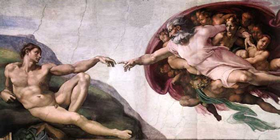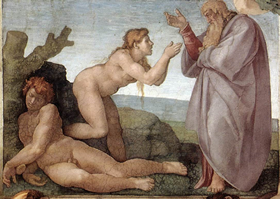|
|
 |
Sophia Ilongga
wrote:
|
|
Hi, guys—
I know that images and statues are not prohibited in our church because it is biblical.
See Exodus 25:18-20, 2 Chronicles 3:10 and many more passages. I know that Jesus came in flesh and the Holy Spirit manifests Itself in the form of a Dove. My question is:
- Does the Church allow us to have images or statues of God, the Father . . . who is invisible, and
- If the Holy Spirit has its own images and statue aside from a Dove . . . let's say if a sculpture or statue was made of an Image of a Person representing the Holy Spirit, . . .
Is this prohibited according to the:
- Tradition
- Magisterium, or
- authority of the Catholic Church?
Thanks
Sophia
|
|
{
Does the Church allowed us to have images or statues of God, the Father and the Holy Spirit? }
|
|
Mike replied:
|
Dear Sophia,
Because neither God, the Father nor the Holy Spirit are incarnated Persons of the Trinity, you will never see statues of one of those Persons represented as a human statue but you may see an imaginative, creative rendition of statues of God, the Father or the Holy Spirit . . . and there is nothing wrong with that.
I have seen a few pictures like this inside Catholic parishes. They are godly depictions from the creator's viewpoint based on the attributes the Church associated with the God, the Father and God, the Holy Spirit who proceeds from the Father and the Son.
I hope this helps,
Mike
|
John replied:
|
Hi Sophia,
Mike has pretty much covered it but just to add to his comments on the images of the Creator:
We do of course have the famous paintings of Michelangelo on the ceiling of the Sistine Chapel in which we see God creating both Adam and Eve. I've copied and pasted them below.
But we really know, from the Prologue of the Gospel according to John, that the Word, Jesus, in fact was also the Creator, in the form of the spoken Word of God. Jesus also tells us:
If you've seen Me, you've seen the Father. John 14:9
So Michelangelo's image are his own impression of what the Father would look like.


As Mike correctly pointed out, the Father has no body as we understand it. We will see Jesus in Heaven.
I don't know that we will see a Separate Entity but these things are Mysteries.
Hope this helps,
John DiMascio
|
Sophia replied:
|
Thank you very much brothers!
Allow me to ask one more question.
I am aware about celibacy and I believe that because of these verses:
However, what would be our answer if a Protestant used this verse in our discussions:
— 1 Timothy 3:2?
Sophia
|
Eric replied:
|
Sophia,
That means that he can be married no more than once.
It's not a minimum requirement, but a maximum one.
Eric
[Related reference]
|
|
|
|
